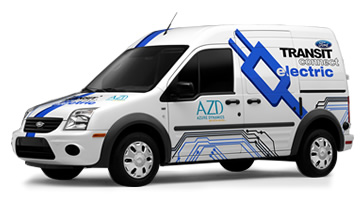-
MATERIAL ISSUES
- Materiality Analysis
-
Climate Change
- Climate Change: Related Commitments and Progress
- Greenhouse Gas Emissions Overview
- Climate Change Risks and Opportunities
- Our Strategy: Blueprint for Sustainability
-
Ford's Sustainable Technologies and Alternative Fuels Plan
- Improving Fuel Economy
- Migration to Alternative Fuels and Powertrains
- Ford's Green Partnerships with the Federal and State Governments
- Progress and Performance
- Climate Change Policy and Partnerships
- Electrification: A Closer Look
- Mobility
- Human Rights
- Vehicle Safety
- Sustaining Ford
- Perspectives on Sustainability
Toolbox
Migration to Alternative Fuels and Powertrains
In This Section

Battery Electric Vehicles (BEVs)
Transit Connect Electric
Ford will introduce a BEV version of the Transit Connect in the United States in 2010, followed by the Focus Electric in 2011. We will introduce these BEVs in Europe in 2011 and 2012.
| 2007 | 2011 | 2020– 2030 |
|---|---|---|
NEAR TERM Begin migration to advanced technology |
MID TERM Full implementation of known technology |
LONG TERM Continue deploying advanced powertrains and alternative fuels and energy sources |
Battery Electric Vehicles (BEVs) |
||
Ford has announced an expanded, comprehensive electric vehicle strategy aligned with growing public interest in advanced technologies that can help reduce the use of gasoline and diesel. We are employing a comprehensive approach to electrification that will tackle commercial issues such as battery cost, standards development and infrastructure deployment. Strategic partnerships are an important part of this new approach. We are working with partners to develop appropriate battery cells, collaborate on government policy and define the infrastructure needed to speed the commercialization and acceptance of electric vehicles. This global electrification strategy is not a test program. It is a vital element of our business plan going forward and is aimed at making Ford a leader in sustainable transportation. To read more about Ford's approach to vehicle electrification, please see Electrification: a Closer Look.
Battery electric vehicles do not have an internal combustion engine and do not use any on-board gasoline. Instead, they use a high-voltage electric motor, which gets its power from a high-voltage battery pack charged by plugging into a standard 110-volt or 220-volt outlet in the United States, or a 230-volt outlet in Europe. Our early BEV test vehicles charge in six hours when plugged into a 220-volt outlet. The production models will be rechargeable in seven to eight hours from 230- and 220-volt outlets or 14–16 hours from a 110-volt outlet. As fast-charge technology standards are developed, Ford's BEVs will be designed to take advantage of this capability. Ford is actively working to help develop the standards to ensure that plug-in and charge stations work for all BEVs and to also ensure that the technology is reliable and durable for customers.
In 2010, we will deliver a BEV version of our Transit Connect light commercial utility van for use by small business owners and fleet customers in the United States. This vehicle is being developed in partnership with Azure Dynamics, a world leader in the development and production of hybrid electric and battery electric commercial vehicles. In 2011 we will deliver a Focus BEV, called the Focus Electric, which will be aimed at U.S. retail customers. We are working with Magna International for the supply and integration of several of the BEV components for this vehicle. This car will have a driving range of approximately 100 miles on a single charge of its lithium-ion high-voltage battery. We are targeting urban markets with this vehicle and expect to sell between 5,000 and 10,000 units annually to start. We will be ready to ramp up to higher volumes as the infrastructure develops and customer demand grows.
We recently announced plans to expand our BEV lineup to Europe. We will launch the Transit Connect Electric in 2011 followed by the Ford Focus Electric in 2012. The Focus Electric will be based on Ford's next-generation Focus model and is one of up to 10 vehicles that will be developed from the company's new global C-car platform. We also plan to introduce two next-generation hybrid-electric vehicles and a plug-in hybrid in Europe in 2013. In preparation for the launch of these vehicles in Europe, Ford will participate in BEV test trials in the UK and Germany with Transit commercial vehicles equipped with a pure electric powertrain as well as battery electric prototype passenger car vehicles, to test the technology's suitability in real-world situations.
In North America, the Society of Automotive Engineers, with Ford's participation, successfully aligned all major original equipment manufacturers on a standard charge connector and communication protocol that will enable all plug-in vehicles to use common charge points. This will be a key enabler for adoption in North America; the same connector is under consideration in Europe and China. Ford also recently announced it is partnering with Microsoft to deliver a new energy management software program called Microsoft Hohm™ that will help owners of Ford BEVs assess the most efficient times to recharge their vehicles. For more information on this partnership, please see Electrification: a Closer Look.
Ford's aggressive new electrification plan represents the next step in the Company's sustainability plan. The plan includes a commitment to greater vehicle fuel economy and lower CO2 emissions as part of Ford's longer-term commitment to addressing climate change and energy security.